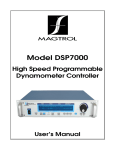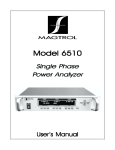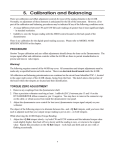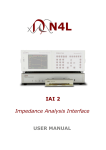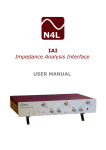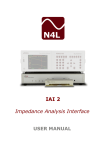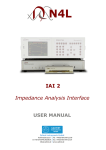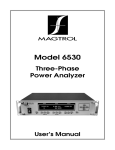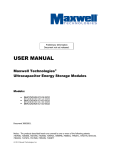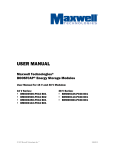Download Model 5600 User`s Manual
Transcript
Model LMU 209 Load Monitoring Unit 1.0 Introduction Figure 1 LMU 209 Load Monitoring Unit 1.1 Description The LMU 209 Load Monitoring Unit is a high-precision, ultra stable DC-measuring amplifier that is capable of various low-level mV-signals. The LMU 209 offers two calibrated outputs, a voltage output and a current output, both according to the industrial standard. Coarse-gain and offset-range are selected with easily accessible DIP-Switches. Fine tuning can be accomplished by adjusting the 10-turn potentiometers. An additional low-pass filter reduces bandwidth and helps to improve signal/noise ratio. The bridge power supply can be selected between 5 V or 10 V DC. The current output is configured from 0–20 mA or 4–20 mA without any calibration. 1.2 Technical Specifications Supply Ripple Voltage Voltage Output Current Output Operating Temperature Range Housing Dimensions 18–28 V / 70 mA max. 1 Vpp / 50 Hz 0 to ±10 V @ Rload 3 kΩ 0/4–20 mA @ Rload 0–800 Ω -20 to +60 °C 44 × 74 × 51.4 mm Housing Material Protection Class Weight EMC Tests Frequency Response F.R. with selectable low-pass filter Sensitivity (default) Sensitivity Ranges PA, Ul94 V-0 polycarbonate - aluminum (option) IP 52 (polycarbonate) or IP 65 (aluminum) 100 g EN 61000-4 0–500 Hz (-3 dB) 0–3 kHz ( -3 dB) 1 mV/V Range 1 : 0.5 to 1.5 mV/V Range 2 : 1.5 to 4.0 mV/V 1 User’s Manual Magtrol Model LMU 209 Load Monitoring Unit Adjustment Sensitivity Zero Adjustment Ranges Zero Fine Adjustment Bridge power supply Input-resistance Sensor 10-turn potentiometer -75% to +75%, in 5 ranges 10-turn potentiometer 5/10 V DC (selectable) 5V: 120 Ω to 10 kΩ 10V: 330 Ω to 10 kΩ 100% (10 V or 20 mA), ± 0.8% max. 20 mVpp 0.05 % < 0.01% / °C Calibration Signal Noise Linearity Error TC Zero 2.0 Safety Use caution and read this operating manual thoroughly before beginning your installation process. Setup, configuration and operation of the LMU 209 should only be conducted by qualified personnel. 2.1. Proper Use of Equipment • The LMU 209 Load Monitoring Unit must not be used in life-supporting applications. • The LMU 209 Load Monitoring Unit must not be used in safety-critical applications. 2.2 Safety Precautions Non-compliance with the safety regulations could result in serious damage to the unit. • Always separate the signal lines from power lines (drives, converters) and never interrupt the signal lines unless using designated junction boxes. • Attach the cable shield (braid) at both ends to a proper ground. Do not allow a ground current to flow over the cable shield. • Attach all machine parts to one well defined potential by using large copper wires. Allowing different potentials will create currents that cannot be controlled. 3.0 Installation For quick and easy installation, select the operating mode as shown in “default position” section 3.2.1. Caution: Make sure the switches are in their correct end position. If in doubt, toggle the switch again with the appropriate tool. Configuration can be done in the powered operate mode. 3.1 Connection Diagrams 2 User’s Manual Magtrol Model LMU 209 Load Monitoring Unit 3.1.1 Supply Connection and Signal Output Connection +Ub 0V Uout Iout 0V 1 2 3 4 5 Power supply, 18–28 V Power supply 0 V (Ground) Calibrated voltage output Calibrated current output Signal 0 V for UOUT and IOUT 0V PWR + I 0V Signal U I Out + 3 4 5 U Out + 1 2 +24VDC Figure 2 Connection to Power and Control Unit 3.1.2 Sensor Connection +15V E+ Sen+ S+ SSenEEarth 16 15 14 13 12 11 10 9 Auxiliary supply output for external sensors (draw max. 20 mA) Positive bridge excitation (5 V/10 V) Sense input + (6-wire technique) Positive signal input Negative signal input Sense input – (6-wire technique) Negative bridge excitation 0 V Connection for grounding 9 10 11 12 13 14 15 16 HFE Excitation- Signal- Signal+ Excitation+ +15V Figure 3 Connection of Resistive 4-wire Sensor 3 User’s Manual Magtrol Model LMU 209 Load Monitoring Unit 9 10 11 12 13 14 15 16 HFE Excitation- SenseSignal- Signal+ Sense+ Excitation+ +15V Figure 4 Connection of Resistive 6-wire Sensor (contact Magtrol SA for information) max. 20 mA 10 11 12 13 14 15 16 15 V 9 Auxiliary Load HFE Excitation- SenseSignal- Signal+ Sense+ Excitation+ +15V Figure 5 Use of LMU 209 Auxiliary Power 3.2 DIP Switches OFF Position DIP Switches ON Position Excitation 10V N/A Excitation 5 V Sensitivity Range 1 ON N/A Sensitivity Range 2 ON N/A- Offset Range -50% (±20%) N/A- Offset Range -25% (±20%) N/A- Offset Range -0% (±20%) N/A- Offset Range +25% (±20%) N/A- Offset Range +50% (±20%) Cut-Off Frequency 3 kHz Cut-off Frequency 500 Hz Zero Current Out 0 mA Zero Current Out 4 mA 4 User’s Manual Magtrol Model LMU 209 Load Monitoring Unit 3.2.1 Default Position SW 1 SW 2 SW 3 SW 4 SW 5 SW 6 SW 7 SW 8 SW 9 SW 10 4.0 ON ON OFF OFF OFF ON OFF OFF ON ON 5V Excitation Range 1 selected Offset adjusting range 0% ±20% Bandwidth is limited DC–500 Hz Current Out 4–20 mA Operation The LMU 209 is designed to amplify low-level signals from force, pressure or strain-sensors based on strain gauge principles. After supplying the LMU 209 with power, it is immediately ready for measuring and will deliver a measuring signal at the signal outputs which is in perfect proportion to the input signal, coming from the connected sensor. Depending on the sensor’s offset, it may be necessary to adjust the potentiometer ZERO. 4.1 Offset calibration The LMU 209 is optimized for static-measurement, as in force measuring and weighing applications. If an exact proportional signal without any offset or zero-errors is desired, the zero of the whole measuring chain has to be adjusted after installation. If the zero error is within a few percent, this error can be adjusted by using the zero potentiometer. However, if the zero-offset is larger, the DIPswitches can be used to adjust the range. The DIP-switches can also be used to adjust for preload or packaging weights. ZERO potentiometer 10V potentiometer Calibrate button Figure 6 DIP-switches and Zero Potentiometer 5 User’s Manual 4.2 Magtrol Model LMU 209 Load Monitoring Unit Adjusting Input Sensitivity The default input sensitivity of the LMU 209 is adjusted to 1mV/V in conjunction with a bridge supply power of 5 V. To adapt the LMU 209 to other signals, other ranges are easily selectable with the DIP-switch or by adjusting the calibration with the potentiometer in large ranges. Caution: Adjusting the calibration will result in a loss of factory calibration. Therefore only qualified personnel should recalibrate the LMU 209. 4.3 Calibration The LMU 209 contains a calibration button for quick and easy calibration. By pressing the CALIBRATE button, the LMU 209 creates an internal signal of 1mV/V to the input. 4.3.1 Calibration procedure 1. Calculate the sensor signal in mV/V for a 10V output span. 2. Connect the sensor to the LMU 209. 3. Adjust the output to 0.00 V with the ZERO potentiometer (see Figure 6) 4. Press the CALIBRATE button (see Figure 6) 5. Adjust the voltage-output with the 10V potentiometer (see Figure 6), according to the following formula: UOUT (Volt) = 10V × 1 (mV/V) Sensor signal (mV/V) Example: A 5 kN force-sensor should measure a force of 3.5 kN, whereas this sensor is specified with 2.00 mV/V at 5kN. Therefore, the sensor’s output will be 1.40 mV/V at 3.5 kN. According to the formula above, the output needs to be adjusted to 7.143 volts when the calibration button is pressed. After this, the LMU 209 will deliver 10.00 V (or 20 mA) at the outputs when the sensor is loaded with 3.5 kN. The voltage output can handle bipolar signals and will therefore also deliver -10 V. In the example above, negative forces can also be measured as long as the sensor itself is designed to do so. 4.4 Current output The LMU 209 offers two simultaneous calibrated outputs, a voltage output and a current output. The relationship between these two outputs is strictly proportional. In other words, if the voltage output is forced to 100%, the current output will also go to 100%. Definition: UOUT 0 to +10 V = IOUT 0–20 mA or 4–20 mA 6 User’s Manual Magtrol Model LMU 209 Load Monitoring Unit 4.5 Grounding (HFE) The LMU 209 provides outstanding EMC capabilities but still needs to be connected to an earthground. This connection should be made with a short wire with at least AWG22. If an earth-ground is not possible, attach this connection to 0 V or a mounting plate or case. Make sure that the HFE is connected to a proper earth-ground to sink the energy which is absorbed by the EMC circuit integrated in the LMU 209. 4.6 Power Bridge power can be selected between 5 V DC or 10 V DC. As a general rule, low impedance sensors should be driven with 5V whereas high impedance sensors can be operated with 10V. If in doubt, select the lower supply voltage. This helps to reduce sensor overheating. 4.7 6-wire Technique Contact Magtrol SA for additional information 4.8 Low-Pass Filter The onboard low-pass filter is switched on and off by toggling the appropriate DIP Switch. It is recommended to reduce the bandwidth, because it eliminates high-frequency noise and gives more stability to the readings. If an application needs more speed, switch off the low-pass filter in order to achieve a bandwidth up to 3000 Hz. 5.0 Maintenance Any repairs should be performed exclusively by Magtrol. 1st Edition – January 2009 Testing, Measurement and Control of Torque-Speed-Power • Load-Force-Weight • Tension • Displacement Magtrol Inc 70 Gardenville Parkway Buffalo, New York 14224 USA Phone: +1 716 668 5555 Fax: +1 716 668 8705 E-mail: [email protected] Magtrol SA Route de Montena 77 1728 Rossens / Fribourg, Switzerland Phone: +41 (0)26 407 3000 Fax: +41 (0)26 407 3001 E-mail: [email protected] 7 www.magtrol.com Subsidiaries in: Germany • France China • India Worldwide Network of Sales Agents







